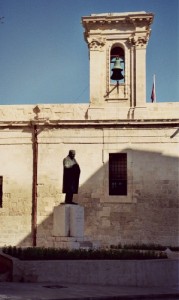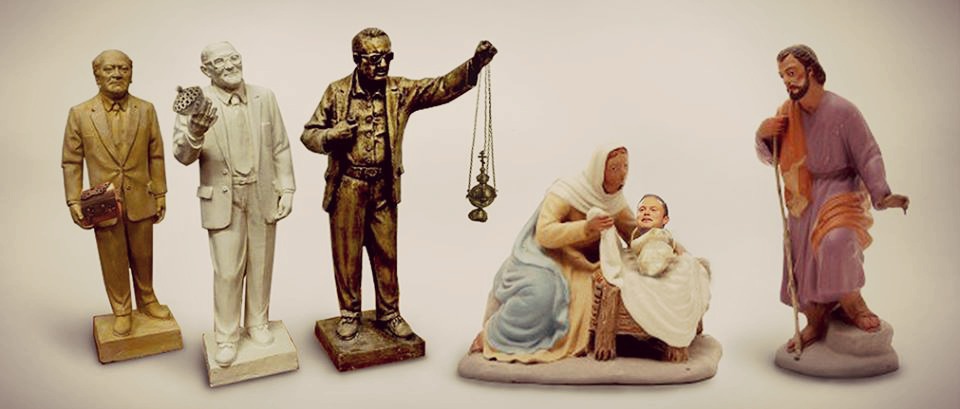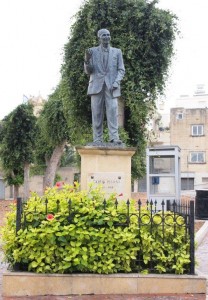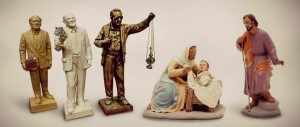There is a symbolical effervescence that pervades anyone with the right frame of mind as he walks around great cities such as Rome or Washington D.C. The former is richly endowed with a magnificent scattering of monuments built to last centuries and that eagerly proclaim the magnificence of a proud republic and empire. The latter with its purposely structured fora displaying the symbolic pride of the a government by the people for the people as ordained and designed by the freemasons that built America.
That’s it really. Monuments – from the poignant obelix to the triumphant arch to the sombre cenotaph – are repositories of meaning and dignity. When it comes to persons and personalities the statue that adorns the monument has at least a twofold raison d’etre – more often than not the effigy is intended to be a true likeness of the person in question (history has of course given us myriad Berlusconi’s and Sarkozy’s who have had their effigies adulterated to better please their conception of themselves). The second reason of the existence of the effigy is the importance of the person whose likeness is being transferred to stone.
The hermeneutics of statues as monuments are fascinating to say the least. Even the poise of a horse – in the case of a cavalier statue – can transmit meaning. Controversies might abound as to the choice of one poise against another – as well as to the nature of the likeness that is ultimately chosen. Statues are supposed to “carry” the dignity of the person being portrayed and one glance at the person portrayed as frozen for eternity must be able to give the onlooker a sense of gravitas. This here, is what the person in stone was all about.
I have two statues in Malta to heart for different reasons. The first is that of Paul Boffa standing facing the Auberge de Castille in Valletta. Barely a toddler I used to be walked past this statue daily on the way to a shop that my mum used to run close by. That corner of Valletta got imprinted in my head, together with the oldest church in the city, the very British lamps and the little pieces of greenery on the roundabouts. As I grew up that idea of Boffa as a politician who deserved a respectful place in our history remained – even when as a student I camped right under his outstretched arm in protest against a labour government’s failure to listen to the people.

The second statue is that of Gozitan poet Gorg Pisani. The statue stands at a corner of the Victoria Bus Terminus (Putirjal as the Gozitans would call it) and just opposite the old house where as a youngster I would walk past an already frail George Pisani sitting on his parapet and nodding at passers by. For some reason the statue standing a few metres away from where his chair stood meant in my mind that Pisani was “preserved” for ever. The old frail likeness was kept for the statue and is a respectful reminder of one of Gozo’s famous sons.
Which brings me to the proposed set of monuments that will supposedly portray (former PM) Dom Mintoff, (former President) Censu Tabone and (former President) Guido De Marco. The picture that has been accompanying these plans swiftly turned into an obligatory set of memes – one of which saw Mintoff’s likeness twerking unceremoniously against Tabone’s likeness. To interpret any sense of disrespect to these great figures of Maltese (and Gozitan) history would be wrong. The memes target the shabbiness of the plans rather than the persons themselves. Rightly so, I would add in a very subjective tone.
There should be a sense of gravitas about the selection of statues that are to serve as monuments to the collective memory. I would go further and state that public spaces should not be made available so easily the moment some foundation or other decides that it wants to commemorate its particular star. In a way we lack the more orderly organisation of the French for example who have a committee of architects and specialists who oversee the development of public spaces. That way not every Tom, Dick and Harry (or overzealous family member) who decides that a statue of his idol should be foisted on the general public can go about planting these in any place.
Back to the current three. Without making too much of a fuss about it, it is in any case important to set some standards. Statues last a bit longer than the ribbons that are used to inaugurate them. In Malta we have many an outrageous example of botched monuments – two that come to mind are the Freedom Day mass of stones and cacti and the Monument to the Labourer in Msida. More recently experiments such as the Love monument in Spinola have also attracted their fair share of derisory comments.
In brief, what I think we need to be aware of is that our choice of statues and symbols is a reflection of the society we live in and want to live in. A bit more thought, away from the gas and heat exchanges would be more than welcome.
“Not marble nor the gilded monuments
Of princes, shall outlive this powerful rhyme,
But you shall shine more bright in these contents
Than unswept stone, besmeared with sluttish time.
When wasteful war shall statues overturn
And broils roots out the work of masonry,
Nor mars his sword nor war’s quick fire shall burn
The living record of your memory.
‘Gainst death and all-oblivious enmity
Shall you pace forth; your praise shall still find room
Even in the eyes of all posterity
That wear this world out to the ending doom.
So, till judgement that yourself arise,
You in this, and dwell in lovers eyes.”– William Shakespeare



